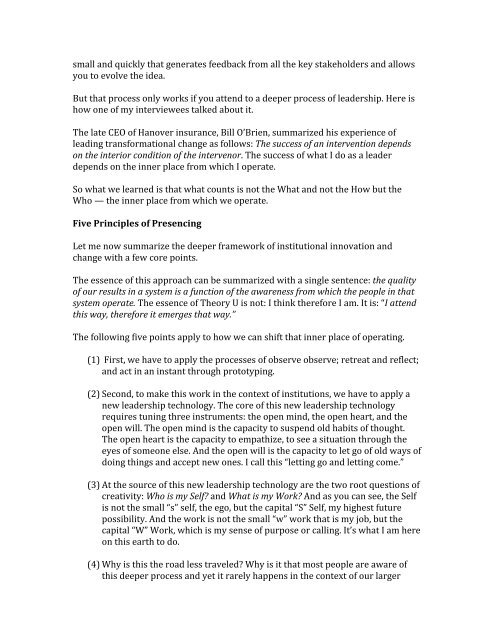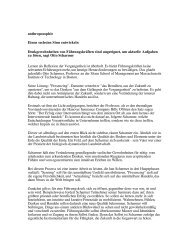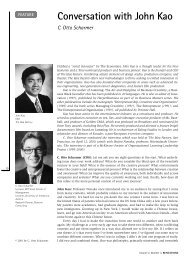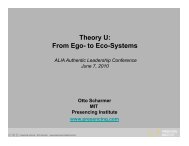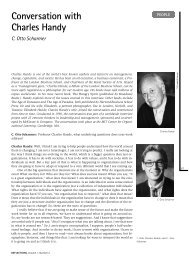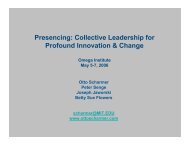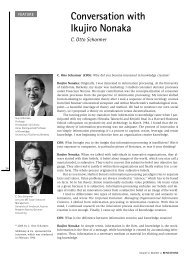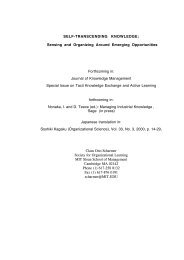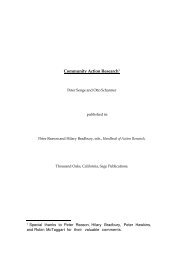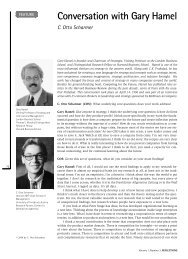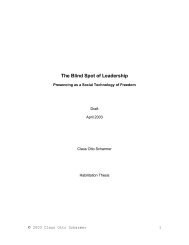Leading from the Emerging Future Minds for Change - Otto Scharmer
Leading from the Emerging Future Minds for Change - Otto Scharmer
Leading from the Emerging Future Minds for Change - Otto Scharmer
Create successful ePaper yourself
Turn your PDF publications into a flip-book with our unique Google optimized e-Paper software.
small and quickly that generates feedback <strong>from</strong> all <strong>the</strong> key stakeholders and allows<br />
you to evolve <strong>the</strong> idea.<br />
But that process only works if you attend to a deeper process of leadership. Here is<br />
how one of my interviewees talked about it.<br />
The late CEO of Hanover insurance, Bill O’Brien, summarized his experience of<br />
leading trans<strong>for</strong>mational change as follows: The success of an intervention depends<br />
on <strong>the</strong> interior condition of <strong>the</strong> intervenor. The success of what I do as a leader<br />
depends on <strong>the</strong> inner place <strong>from</strong> which I operate.<br />
So what we learned is that what counts is not <strong>the</strong> What and not <strong>the</strong> How but <strong>the</strong><br />
Who — <strong>the</strong> inner place <strong>from</strong> which we operate.<br />
Five Principles of Presencing<br />
Let me now summarize <strong>the</strong> deeper framework of institutional innovation and<br />
change with a few core points.<br />
The essence of this approach can be summarized with a single sentence: <strong>the</strong> quality<br />
of our results in a system is a function of <strong>the</strong> awareness <strong>from</strong> which <strong>the</strong> people in that<br />
system operate. The essence of Theory U is not: I think <strong>the</strong>re<strong>for</strong>e I am. It is: “I attend<br />
this way, <strong>the</strong>re<strong>for</strong>e it emerges that way.”<br />
The following five points apply to how we can shift that inner place of operating.<br />
(1) First, we have to apply <strong>the</strong> processes of observe observe; retreat and reflect;<br />
and act in an instant through prototyping.<br />
(2) Second, to make this work in <strong>the</strong> context of institutions, we have to apply a<br />
new leadership technology. The core of this new leadership technology<br />
requires tuning three instruments: <strong>the</strong> open mind, <strong>the</strong> open heart, and <strong>the</strong><br />
open will. The open mind is <strong>the</strong> capacity to suspend old habits of thought.<br />
The open heart is <strong>the</strong> capacity to empathize, to see a situation through <strong>the</strong><br />
eyes of someone else. And <strong>the</strong> open will is <strong>the</strong> capacity to let go of old ways of<br />
doing things and accept new ones. I call this “letting go and letting come.”<br />
(3) At <strong>the</strong> source of this new leadership technology are <strong>the</strong> two root questions of<br />
creativity: Who is my Self? and What is my Work? And as you can see, <strong>the</strong> Self<br />
is not <strong>the</strong> small “s” self, <strong>the</strong> ego, but <strong>the</strong> capital “S” Self, my highest future<br />
possibility. And <strong>the</strong> work is not <strong>the</strong> small “w” work that is my job, but <strong>the</strong><br />
capital “W” Work, which is my sense of purpose or calling. It’s what I am here<br />
on this earth to do.<br />
(4) Why is this <strong>the</strong> road less traveled? Why is it that most people are aware of<br />
this deeper process and yet it rarely happens in <strong>the</strong> context of our larger


